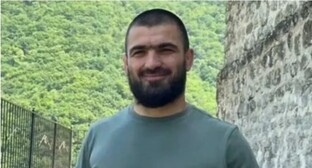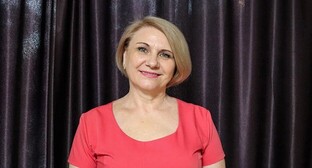06 May 2003, 13:20
Yessentuki
City in Stavropol kray (region), kray subordination, 213 km south-east of Stavropol, balneal and muddy health resort of All-Russian significance in the group of health resorts of the Caucasian Mineral Waters. Located in the south of the Stavropol Upland, at the height of 650 m, in the valley of the Podkumok River, to the north of the Skalisty Ridge foothills of the Greater Caucasus.
The climate is moderately continental. Winter is mild, with thaws; the temperature in January averages to -4?С; severe frosts sometimes take place; mists are frequent. Spring is short, sometimes the weather is cool, rainy (mostly in April). Summer is warm, with a large number of hot and dry days; the temperature in July averages to 20?С. Autumn is warm and lasting; the temperature in September averages to about 15?С. Precipitations of about 500 mm a year. A large number of clear, sunny days (280 a year on average) is characteristic. The open position in the east and in the west makes Yessentuki accessible for winds prevailing here: dry eastern ones, which are hot in summer and cold in winter; and wet south-west ones, cool in summer and warm in winter.
Railway station in the Mineralny Vody - Kislovodsk branch, 43 km south-west of Mineralny Vody and 17 km west of Pyatigorsk. Population (1992 est.) 87.1 thousand, (1897 est.) 4.4 thousand, (1926 est.) 7 thousand, (1939 est.) 16 thousand, (1959 est.) 48 thousand, (1970 est.) 65 thousand, (1979 est.) 65 thousand.
In 1798, the Russian military and border redoubt of Yessentuksky was laid on the right bank of the Bolshoy Yssentuchyok River, near its confluence with the Podkumok River. After construction of the Kislovodsk fortress (founded in 1803), the redoubt was abolished, and the Cossack post was only kept on its site. The mineral waters of Yessentuki were first probed in 1810 by the Moscow doctor F.P. Gaaz. Gaaz found 2 small wells with source-salty water (the present Gaazo-Ponomaryovsky spring) in the valley of the stream of Kislusha, about 4 km north-east of the Yessentuksky post. Detailed study of Bugunta mineral waters (the original name of the waters after the Bugunta River flowing nearby) was made in 1823 by the Russian doctor and pharmacologist A.P. Nelyubin, who found 20 more mineral springs on the slopes of the mountain he referred to as Shchelochnaya (A.P. Nelyubin's numbering of the Yessentuki mineral waters has been preserved until now). In 1825, General A.P. Yermolov initiated foundation of the stanitsa (Cossack village) of Yessentukskaya on the Bugunta River 3.5 km north-east of the former Yessentuksky post; its inhabitants were engaged in trade, trucking and service of arriving patients. In 1839, water of springs No. 23-26 was led to the common pool, where the first wooden bath-house was built (2 baths) at the expense of the Cossack Regiment Management. Since 1840, springs No. 4 and 17 have come into use and become especially popular. Yessentuki was recognised as one of the best health resorts for treatment of digestion organs. In 1846, Prince M.S. Vorontsov, the vicegerent of Caucasus, ordered to extend the territory of the Yessentukskaya stanitsa to the north-east to approach the springs. Since then, Buguntinskiye mineral waters were referred to as Yessentukskiye. In 1847, some grounds closely adjacent to the springs were transferred to the specially established state Management of Waters in Pyatigorsk. In the late 1840s, bottling of Yessentuki waters and their dispatch to other cities of the country began. By the early 1870s, regular sale of the water was carried out in most of the large Russian cities. Construction of the Rostov-on-Don - Mineralny Vody railway in 1875 and the Mineralny Vody - Kislovodsk highway (via Pyatigorsk and Yessentuki)contributed to increase in the number of guests coming to Yessentuki for treatment. In 1883, the health resort was visited by about 5 thousand people; in 1900, by more than 13 thousand; in 1913, by 38.6 thousand. In the late 19th and the early 20th centuries, medical establishments, hotels and summer residences were intensively built. In 1902, a sanatorium for the poor (70 beds), the first one within the Caucasian Mineral Water system, was opened; in a year, the first departmental sanatorium for post workers (20 beds) was built. In 1905, drilling of holes resulted in discovery of new springs (main spout of spring No. 17, new discharges of the water similar to the one of spring No. 4, etc.).
Fast growth of the Yessentuki health resort in the last third of the 19th and the early 20th centuries attracted famous representatives of Russian culture, including the writers V.G. Korolenko, A.I. Kuprin, M. Gorky, the poet K.D. Balmont, the composers S.I. Taneyev, S.V. Rakhmaninov, S.S. Prokofyev, the singer F.I. Shalyapin, the theatrical figures M.G. Savina, V.F. Komissarzhevskaya, K.S. Stanislavsky.
In 1917, the resort area was separated from the stanitsa of Yessentukskaya and received the status of a town. During the Civil war, resort facilities of Yessentuki fell into decay. Restoration work began only in 1920. In 1922, the clinical branch of Pyatigorsk Balneal Institute (the present Pyatigorsk Research Institute of Balneology and Physiotherapy) was opened. In 1925, the health resort operated 6 sanatoriums and treated the total of about 13 thousand patients. During the Great Patriotic War of 1941-1945, the health resort was heavily damaged by Nazi occupation (from August 10, 1942 to January 11, 1943) and was restored at the end of the 1940s.
In 1991, Yessentuki provided rest and treatment for more than 217 thousand patients. In 1991, the health resort operated 25 sanatoriums, including 10 trade-union ones (the number of beds totalling to more than 10 thousand), as well as provided out-patient treatment and board and treatment authorisation. Service of guests involved such facilities as a resort polyclinic with aerosun rooms and climatic pavilions; a therapeutic mud bath; 3 bath-houses: Nizhniye baths (50 baths), Verkhniye baths (90 baths) and a new bath-house (110 baths); 4 drinking galleries and well-rooms of springs No. 4 and 17; an inhalatorium shared by all the resorts; a department of mechanotherapy, applying special techniques of therapeutic physical training.
Of all mineral springs of Yessentuki, about 20 are of medical value. Sodium carbonic hydrocarbonate-chloride (i.e. salt-alkaline) water of springs No. 4 and 17, which have made the health resort popular, are the most famous and therapeutically valuable. The thermal waters (35.5-46?C) similar to the waters of springs No. 4 and 17 in their structure have been led to the surface in the vicinities of the village of Blagodarnoye (7-9 km north-east of Yessentuki). The water of springs No. 4 and 17 and their analogues are used for peroral treatment. Carbonic hydrogen-sulphide water of holes No. 1 and 2, as well as calcium-sodium hydrosulphuric sulphate-hydrocarbonate (the so-called sulphur-alkaline) water of the Gaazo-Ponomarevsky spring are used for baths, lavages, inhalations and other balneotherapeutic procedures. Calcium - magnesium sulphate-hydrocarbonate water of spring No. 20 is used for baths. The water of springs No. 4 and 17 is bottled by a local bottler as a healing water (No. 17) and as a healing table water (No. 4) under the name of Yessentuki.
Alongside with mineral waters, the medical establishments of Yessentuki uses sulphide silt muds of Tambukan Lake (6.5 km south-east of Pyatigorsk). Besides, climatotherapy, electrochromophototherapy, etc. are widely used. The health resort specialises in treatment of patients with diseases of digestion organs, as well as patients with metabolic disorder.
The city has enterprises of food-processing industry (a cannery, a dairy factory, a brewery, a meat-processing plant, etc.), a knitting mill, a clothes and a shoe factory.
The oldest architectural monument of Yessentuki is the wooden St. Nicholas's Church (built in the middle of the 1820s, presumably, by the architects Giovanni and Giuseppe Bernardacci) in the centre of the former stanitsa. The orthogonal lay-out of the city, dating back to the middle of the 19th century, and a regular residential building-up of the second half of the 19th and the early 20th centuries, have been preserved here, in the southern end of Yessentuki. The resort area is to the north-east of the stanitsa part of Yessentuki. Its core is the extensive Kurortny (Glavny) Park (planted mostly with ash, oak, hornbeam, chestnut, maple, poplar, linden, etc., decorative bushes, flowers), laid in 1849, with springs of mineral water and numerous constructions: the building of the drinking gallery (1847-1856, architect S. Upton, Moresque style), the Nikolayevskiye (the present Verkhniye) baths (1899, architects N.V. Dmitriyev and B.V. Pravzdik), the Commercial gallery (1912, architect Y.F. Shreter, neo-classicism; the present Electroheliotherapy Institute), the wooden observation pavilion with colonnade referred to as Oreanda (1912), 4 pavilions above drinking well-rooms (1912-1913, architect N.N. Semyonov, neo-classicism), etc. The majority of sanatoriums and boarding houses are concentrated around the Glavny Park. The area to the north from the Park (between the latter and the railway line) was developed since the end of the 19th century as a zone for private sanatoriums and villas (Orlinoye gnezdo villa, 1912-14, Art Nouveau), resort constructions; the monumental building of the therapeutic mud bath in the spirit of ancient Roman thermae decorated with a mighty Ionic portico and numerous sculptures (1913-1915, architect Shreter, sculptors L.A. Ditrikh and V.V. Kozlov). In 1903, the Angliysky Park was laid out behind the railway line.
The main of modern industrial and residential building is the so-called Noviye Yessentuki. Among significant structures of the middle of the 20th century, one should mention 4 solemn entrances to the Kurortny Park (mid-1950s, architect P.P. Yeskov), drinking gallery of spring No. 4 (1967, architect V.N. Fuklev), the Ukraina sanatorium (1972), etc.





Комментирование через Кавказский узел